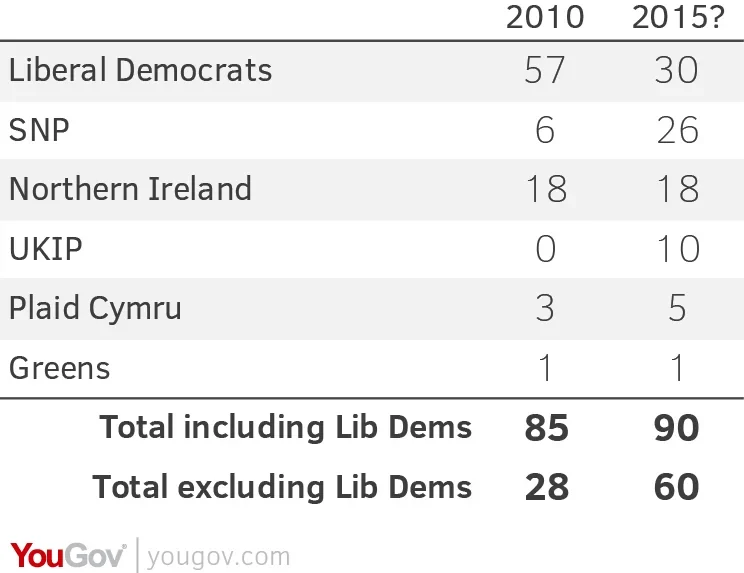Why the days of decisive, first-past-the-post election outcomes in Britain might be over
For a moment, forget the ‘English question’. Even if it were answered tomorrow to everyone’s complete satisfaction, governing Britain could soon become a whole lot harder.
In recent months it has looked unlikely that either Labour or the Conservatives would win an overall majority next year. There is now a real chance that neither will have a secure majority, even in coalition with the Liberal Democrats.
To see why, let’s start with what happened last time. In 2010, The Conservatives won 307 seats Labour 258 and the Lib Dems 57. Other parties won 28. Thanks to the Tories not falling too far short of the 326 winning post, and the Lib Dems winning the lion’s share of the non-two-party seats, David Cameron and Nick Clegg could lead a coalition with a comfortable majority of 78.
Now, let’s imagine four things happening next year. Two have been likely for some time, while the other two, though less probable, have become much more plausible in the past fortnight.
The two likely features of election night next May are that Labour and the Conservatives will end up with similar numbers of MPs and that the Lib Dems will suffer serious losses. If nothing else changed, a Lib-Lab or Lib-Con coalition would probably still have a majority, albeit a far smaller one than in 2010.
However, the prospect recedes if Ukip and the Scottish National Party have a bigger impact than seemed likely a few months ago.
Ukip first. I would expect Mark Reckless to hold his seat for Ukip in the coming by-election. As in Clacton, which Douglas Carswell is likely to win next week with a stonking majority, Reckless will be defending his seat, Rochester and Strood, just a few months after Ukip outpolled the Conservatives locally by around two-to-one in the European parliament elections in May.
The loss of a single seat would be embarrassing to the Tories but, on its own, not fatal. But imagine the dynamics of the months leading up to next year’s general election. Ukip will secure a big burst of publicity when it wins Clacton next week – and another burst a few weeks later when Reckless holds his seat. Ukip will have two MPs able to command attention in the House of Commons.
Ukip could then become one of the stories in next year’s general election. It is likely to command media attention far beyond anything it has managed outside European elections. It stands a real chance of gaining the kind of credibility that seemed improbable until recently. Earlier this year, I thought Ukip would probably win no seats next year. I can now envisage them winning up to ten: Carswell and Reckless for a start, with Nigel Farage probably winning in Thanet South, Diane James possibly winning in Eastleigh, where she came close in last year’s by-election, and half a dozen other seats along England’s east coast between the Humber and the Channel.
The second factor that could upset the electoral apple cart is Scotland. The SNP lost the independence referendum, but the result was much closer than seemed likely before the summer. The London-based parties have now offered Edinburgh more powers. These will need legislation in the new Parliament after next May. This gives the SNP a perfect election platform: ‘Vote SNP to force London to keep its promises’.
In 2010, Labour won 41 seats in Scotland with 42% of the vote, while the SNP won six with just 20%. In the 2011 Holyrood elections, the SNP outpolled Labour by 45% to 32%; in this year’s European Parliament elections, the SNP outpolled Labour by 29-26%. In this month’s referendum, Labour failed to persuade hundreds of thousands of its traditional supporters to vote against independence. Plainly Labour has big problems north of the border. Parity in votes between SNP and Labour next May now looks perfectly possible. This could give the SNP up to 20 more seats, mainly at Labour’s expense.
Now let’s draw these things together, assume the Lib Dems end up with 30 seats, and add in Northern Ireland’s 18 seats, two gains for Plaid Cymru in Wales and Caroline Lucas holding Brighton Pavilion for the Greens. This is how the next House of Commons could look, in terms of minority party MPs:

Secondly, even to form a majority coalition with the Lib Dems, either Labour or the Tories needs significantly more MPs than the other. On these figures, the total number of Labour and Conservative MPs would be 560. At the very least, one of them would have to win 296 seats, which would mean limiting its rival to 264. And to have a working majority of, say, 20, the target would be 305, and a 50 seat lead over the other. If that is what happens, then simple arithmetic tells us two things. In order for either Labour or the Conservatives to win outright, one needs to have at least 90 more seats than the other. That looks improbable; but the political futures market has long assumed the likelihood of another hung Parliament.
Imagine a dead heat, with Labour and the Tories winning 280 seats each. Adding in the Lib Dems would take the prospective coalition total to just 310, still 16 seats short of the 326 needed for an overall majority. Forming an effective government in Westminster would become a nightmare.
That possibility could not arise with the Lib Dems winning 57 seats, as they did in 2010, compared with 28 for the other minority parties. Then, with the two main parties winning a combined total of 565 seats, parity would have meant a 283-282 division. Add in the 57 Lib Dems, and either Labour or Conservatives could have secured a coalition with at least 339 MPs and a majority of at least 28.
Here’s the bottom line. The basic arithmetic is simple and potentially devastating. In order for us to be certain that a viable two-party coalition with the Lib Dems is available to at least one of the two main parties, the number of Lib Dem MPs must exceed the total of the other minority parties. This was the position in 2010, when the Lib Dems won twice as many seats as the combined total of Green, nationalist and Northern Ireland parties.
However, the prospects change dramatically if the Lib Dems do NOT dominate the ranks of the smaller parties. In my scenario for next year, the 2010 positions are reversed: 60 ‘other’ MPs compared with 30 Lib Dems. This would transform the arithmetic of coalition building. A close Labour-Tory race would prevent the formation of either a majority Lib-Lab or Lib-Con coalition. Any Prime Minister would need to look elsewhere for extra support. Would Cameron need to buy off Ukip? Would Miliband need a deal with the SNP? In either case, would we have a three-party coalition or some other confidence-and-supply arrangement?
Having laid out one possible scenario, I should make clear this is NOT a prediction. I would expect Ukip and the SNP to win fewer seats than I have set out in this illustration. But crossover is entirely possible. That is, the decline in Lib Dem support could leave them with fewer MPs than the combined ranks of the ‘other’ minority party MPs. If that happens there is a real possibility that the parliamentary politics of the House of Commons will be exceedingly messy.
This would be new to Britain, but not to the world of modern democracies. Other countries are familiar with multi-party parliamentary politics. Sweden is grappling with the awkward aftermath of its recent election. It is only the latest of a line of countries to face this predicament. The complex arithmetic of coalition-formation underpinned the terrific Danish TV series, Borgen.
Britain’s first-past-the-post system is supposed to be different. It is meant to produce single-party majority governments. Indeed, one of the most compelling arguments against proportional voting systems was that they made for messy, indecisive election outcomes, in which politicians rather than voters determined who should form the government. To avoid that is arguably a price worth paying for our ‘unfair’ voting system, which punishes smaller parties with geographically dispersed support.
Those days of decisive, first-past-the-post election outcomes might be over, at least for the time being. If SNP remain strong in Scotland, and Ukip can put down roots in parts of England, then it will be only a matter of time – next year? 2020? 2025? – before the business of creating a viable government in London becomes a great deal more complicated than it has ever been before.
Image: PA
Want to receive Peter Kellner's commentaries by email? Subscribe here









